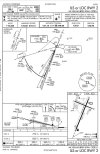I am a CFI INST and have an Instrument student. Been CFI-I-ME for 33 years but have not instructed much last 20 years. In that time GNS430W came out 18 yrs ago. So I am learning as well. Airliners don't have Garmin. I am pretty proficient with the 430W, with RNAV approaches. However something happened with waypoint cycling on a DME arc to LOC approach.
I wanted my student to do a LOC approach, as well as a DME arc, timed approach, and more complicated missed. The KMKL LOC 02 was pretty much made to order. All we had done were very basic or typical RNAV LPV approaches with HOLD entry. A
The plane has a GNS430W and two G5's. Only non GPS approaches it can do are VOR, having no GS receiver. It may also be limited by having no DME. That is OK as the LPV counts as a precision approach for check. [Agree LVP is substitute for ILS on check ride?]
My issue is the GPS did not cycle as expected from Arc to final approach segment. Keep in mind the plane has all the IFR requirements and current Garmin IFR database.
So off we went VFR to to KMKL for the ILS or LOC 2 in VFR, student under hood. Contacted KMKL tower about 5 miles from IAF SKOAL, start of 12 DME arc. Keep in mind the approach says:
"DME required. RADAR required for procedure entry."
So that is clear. GPS is not an acceptable substitute for DME on this Approach. Since we were in VFR no issue. Also the RADAR required for procedure entry? [Comments and Thoughts]
Before you all bash me all the planes I have flown recently have 2 DME, 2 GPS, LOC/GS/MB and 3 IRU's, all integrated into one FMS. The other GA plane I fly has GTN750 with all the bells, whistles and options.
Approach is loaded and activated. Proceeded direct to SKOAL. The GNS430W gave turn guidance to start the ARC which was magenta. All is good.
So what happened? First is DME really needed to do this in IMC or is an IFR GPS a substitute?
What was the issue with way point cycling (if any)? Other approaches with a HOLD entry you have to clear the HOLD. You have to clear ARC or bring FAF up?
I called Garmin and the tech said he would test it, see if there is a glitch. Will send me an email. Possible but pretty sure it's me.

.
I wanted my student to do a LOC approach, as well as a DME arc, timed approach, and more complicated missed. The KMKL LOC 02 was pretty much made to order. All we had done were very basic or typical RNAV LPV approaches with HOLD entry. A
The plane has a GNS430W and two G5's. Only non GPS approaches it can do are VOR, having no GS receiver. It may also be limited by having no DME. That is OK as the LPV counts as a precision approach for check. [Agree LVP is substitute for ILS on check ride?]
My issue is the GPS did not cycle as expected from Arc to final approach segment. Keep in mind the plane has all the IFR requirements and current Garmin IFR database.
So off we went VFR to to KMKL for the ILS or LOC 2 in VFR, student under hood. Contacted KMKL tower about 5 miles from IAF SKOAL, start of 12 DME arc. Keep in mind the approach says:
"DME required. RADAR required for procedure entry."
So that is clear. GPS is not an acceptable substitute for DME on this Approach. Since we were in VFR no issue. Also the RADAR required for procedure entry? [Comments and Thoughts]
Before you all bash me all the planes I have flown recently have 2 DME, 2 GPS, LOC/GS/MB and 3 IRU's, all integrated into one FMS. The other GA plane I fly has GTN750 with all the bells, whistles and options.
Approach is loaded and activated. Proceeded direct to SKOAL. The GNS430W gave turn guidance to start the ARC which was magenta. All is good.
- The issue started as we proceeded near the final approach course just inside OZZIE.
- LOC frequency in active, and ready to select VLOC.
- As we passed the end of arc waypoint (not depicted on chart oe FPL) it stayed white and OZZIE did not cycle, also WHITE. There was a gap from end of arc to approach segment from OZZIE to MERSY, still white.
- I deleted the ARC or brought (FAF) MERSY up as next way point (I forgot) mow. The the map showed magenta line.
- VLOC was already selected. G5 was giving guidance, course set, CDI (green). I thought it had to be done manually. May be selecting MERSY selected VLOC automatically?
- We timed approach and did missed. However we did not do published miss but flew West to leave area and return to departure airport.
- The subsequent RNAV LVP at home airport went as expected.
So what happened? First is DME really needed to do this in IMC or is an IFR GPS a substitute?
What was the issue with way point cycling (if any)? Other approaches with a HOLD entry you have to clear the HOLD. You have to clear ARC or bring FAF up?
I called Garmin and the tech said he would test it, see if there is a glitch. Will send me an email. Possible but pretty sure it's me.

.
